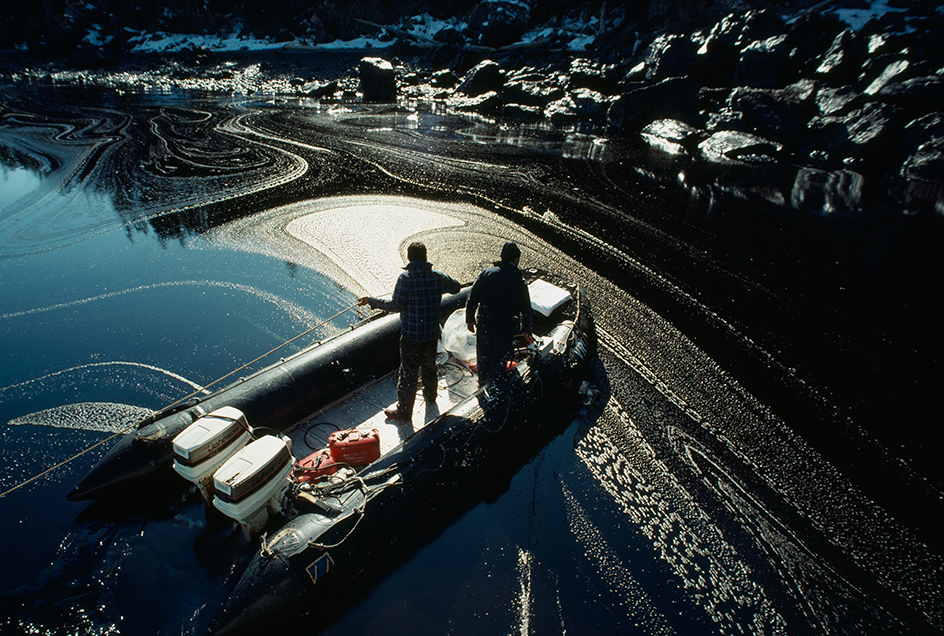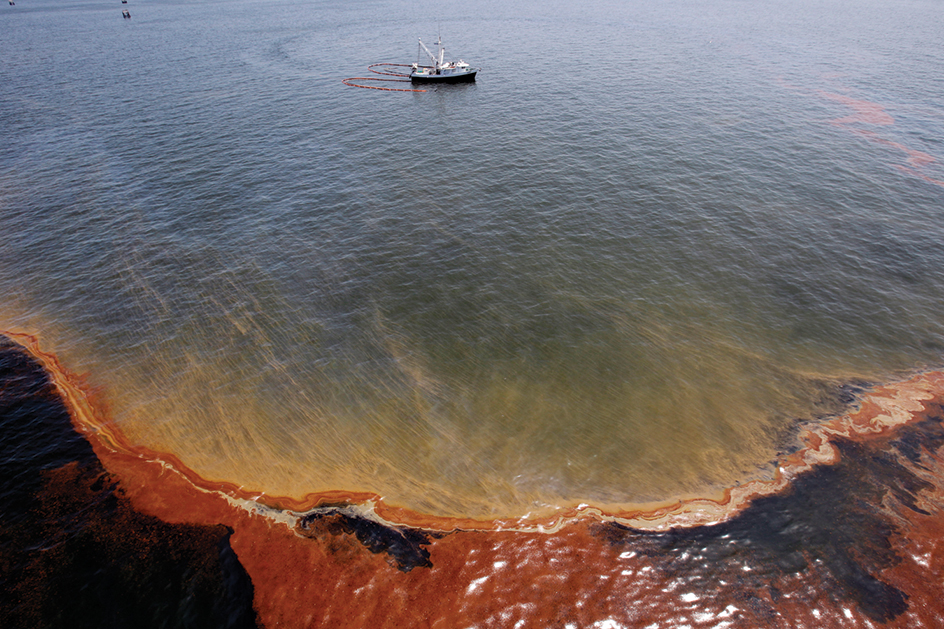Oil spill is the release of petroleum products into the environment. Oil can spill on land, in lakes and rivers, in the ocean, or around coastal areas. Once spilled, oil interacts with the environment in many ways. The oil can cause great damage to living things. Because oil spills are so destructive, people have devised a number of methods to clean them up.

Effects.
Oil is a liquid form of petroleum, which forms deep underground. Most oil is less dense than water. Thus, spilled oil typically floats on water. But the floating oil soon begins to change through a process called weathering. Weathering refers to changes in the chemical and physical properties of the oil after it has been exposed to the environment. Some changes are caused by the activities of living things in the water. As the oil weathers, waves and currents can help break it up into smaller pieces. They may carry the pieces far away from the spill location. In addition, some oil may sink through the water and gather in sediments at the bottom. The oil can remain in sediments for decades.
Birds, turtles, fish, and many other animals can become heavily coated with spilled oil. The animals typically die as a result. Oil can also coat sea grass beds and marshlands. In doing so, it kills plants and poisons animals that live in such areas. In addition, oil contains toxic chemicals that harm living things over a long time. Such chemicals may cause tumors (abnormal growths) or prevent animals from reproducing.
Damaging effects from oil spills can persist in specific areas for decades. A small spill in a fragile environment can cause more damage than a larger spill elsewhere.
Responses.
Workers can set up booms (floating barriers) to block the spread of oil. They can also spread sorbent materials. These materials act as oil-absorbing sponges. Skimmers and nets can also recover oil. Dispersing agents, also called dispersants, are chemicals that push the oil into deeper waters. In bioremediation, cleanup crews apply fertilizers to the oil. The fertilizers increase the activity of microbes (tiny living things). The microbes help break down the oil faster.

No single method of treating an oil spill is ideal. Booms, nets, skimmers, and sorbent materials are ineffective in rough waters and can do little to clean up large spills. Dispersants move oil to other areas in the ocean where it may still pose threats. In addition, the dispersants themselves can be toxic to some ocean life. Bioremediation depends on a sufficient supply of oxygen for the microbes. Workers generally use a combination of response techniques.
Petroleum consists chiefly of two chemical elements: carbon and hydrogen. These two elements combine, forming compounds, in thousands of different ways. A source of oil typically has a unique mixture of compounds. This mixture acts as a chemical “fingerprint.” By examining an oil spill’s fingerprint, scientists can often trace the oil to the party that spilled it. A government can then hold the party responsible for the environmental damage and cleanup efforts.
In the United States, the Environmental Protection Agency (EPA) coordinates the response to oil spills in inland waters or on land. The U.S. Coast Guard coordinates the response for oil spills on the seashore or in the open ocean. Each agency directs the cleanup using private, corporate, and government resources. Other developed countries coordinate responses to oil spills in similar ways. But poor countries often lack the resources or political stability to direct effective responses. Oil spills are common in the Niger Delta region of the African country Nigeria, for example. There, hundreds of millions of gallons (1 billion to 2 billion liters) of oil have probably been spilled since the 1950’s, when oil was first discovered in the region. But the Nigerian government rarely cleans up the oil effectively, and safety features to prevent spills are poorly maintained.
Notable spills.
One of the largest oil spills ever recorded on land began in 1910, in Kern County, California. Over a period of 18 months, about 360 million gallons (1.36 billion liters) of oil spilled out from an uncontrolled blowout at an oil well.
In 1989, the Exxon Valdez oil tanker struck a reef off Alaska, spilling about 11 million gallons (42 million liters). The disaster brought attention to oil tanker safety.
During the 1991 Persian Gulf War, the Iraqi government purposely dumped well over 200 million gallons (760 million liters) of crude oil into the Persian Gulf. Troops also set fire to hundreds of oil wells on land, burning or spilling even greater amounts of oil.
The Gulf oil spill of 2010 was the largest spill ever recorded in U.S. waters. An explosion at the Deepwater Horizon oil rig spilled around 134 million gallons (507 million liters) of oil into the Gulf of Mexico off Louisiana.

